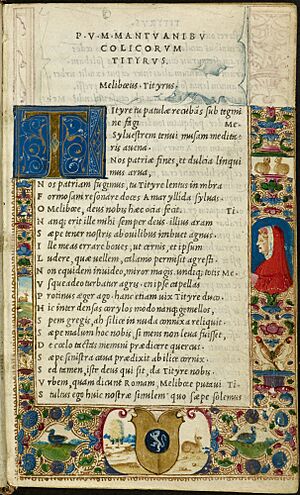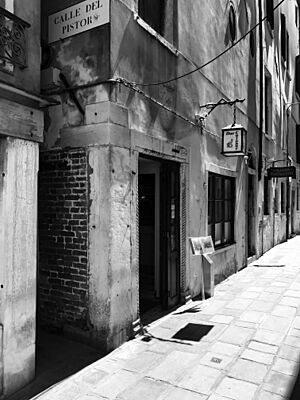Aldine Press facts for kids

The Aldine Press was the printing office started by Aldus Manutius in 1494 in Venice, from which were issued the celebrated Aldine editions of the classics (Latin and Greek masterpieces, plus a few more modern works). The first book that was dated and printed under his name appeared in 1495.
The Aldine Press is famous in the history of typography, among other things, for the introduction of italics. The press was the first to issue printed books in the small octavo size, similar to that of a modern paperback, and intended for portability and ease of reading. According to Curt F. Bühler, the press issued 132 books during twenty years of activity under Aldus Manutius. After Manutius' death in 1515, the press was continued by his wife Maria and her father Andrea Torresani (Andrea Torresano), until Manutius' son Paulus (1512–1574) took over. His grandson Aldus Manutius the Younger then ran the firm until his death in 1597. Today, the antique books printed by the Aldine Press in Venice are referred to as Aldines, as are the letterforms and typefaces pioneered by the Aldine Press.
The press enjoyed a monopoly of works printed in Greek in the Republic of Venice, effectively giving it copyright protection. Protection outside the Republic was more problematic, however. The firm maintained an agency in Paris, but its commercial success was affected by many counterfeit editions, produced in Lyon and elsewhere.
Contents
Beginnings
Aldus Manutius, the founder of the Aldine Press, was originally a humanist scholar and a teacher. Manutius met Andrea Torresani, who had acquired publishing equipment from the widow of Nicholas Jenson. The ownership of the press was originally split in two, with one half belonging to Pier Francesco Barbarigo, the nephew of Agostino Barbarigo, who was the doge at the time, and the other half belonging to Torresani. Manutius owned one fifth of Torresani's share of the press. Manutius was mainly in charge of the scholarship and editing, leaving financial and operating concerns to Barbarigo and Torresani. In 1496, Manutius established his own location of the press in a building called the Thermae in the Sestiere di San Polo on the campo Sant'Agostin, today numero civico (house number) 2343 San Polo on the Calle della Chiesa (Alley of the Church), now the location of the restaurant Due Colonne. Though there are two commemorative plaques located on the building numero civico 2311 Rio Terà Secondo, historians regard them to be erroneously placed based on contemporaneous letters addressed to Manutius. The first erroneous plaque had been placed by Abbot don Vincenzo Zenier in 1828.
Manutius lived and worked in the Thermae in order to produce published books from the Aldine Press. This was also the location of the "New Academy", where a group of Manutius' friends, associates, and editors came together to translate Greek and Latin texts. In 1505, Manutius married Maria, the daughter of Torresani. Torresani and Manutius were already business partners, but the marriage combined the two partners' shares in the publishing business. After the marriage, Manutius lived at Torresani's house. Shrinking in popularity, in 1506 the Aldine Press was moved to Torresani's house in the parish of San Paternian. It was later demolished in 1873 and was covered by a bank building in the Venice square, Campo Manin.
Accomplishments
The press was started by Manutius due to a combination of his love of classics and the need for preservation of Hellenic studies. During its initial era, the press printed new copies of Plato, Aristotle, and other Greek and Latin classics.
The first edition of Plato's works (known as the Aldine edition) was dedicated to Pope Leo X and included the poem of Musurus and the life of Plato by Diogenes Laertius, which were also included in the first two editions of Plato's works printed in Basel. The two Basel editions were introduced by a Latin preface written by the Greek scholar Simon Grynaeus, who dedicated the work to the humanist Thomas More.
Manutius also printed dictionaries and grammars to help people interpret the books, used by scholars wanting to learn Greek, who would employ learned Greeks in order to teach them directly. Historian Elizabeth Eisenstein claims that the fall of Constantinople in 1453 had placed under threat the importance and survival of Greek scholarship, but that publications such as those by the Aldine Press secured it once more. Erasmus was one of the scholars learned in Greek with whom the Aldine Press partnered in order to provide accurately translated text. The Aldine Press also expanded into modern languages, mainly Italian and French.
Humanist typefaces
Manutius eventually took on a project to improve upon the Humanistic font designs of Jenson's typefaces, hiring Francesco Griffo to design and cut typefaces for his print editions of classical literature. Humanistic fonts, based on the formal hand of Renaissance humanist scribes and notaries, had been in development from the time movable print arrived in Italy, notably by Nicolas Jenson in 1470. Griffo developed his own further refinements of style, resulting in one of the earliest roman typefaces produced.
Italic typeface
Adapting this admired and influential roman-faced font, Manutius and Griffo went on to produce a cursive variant, the first of what is now known as italic type. The word italic is derived from early Italian versions of italic faces, which were designed primarily in order to save on the cost of paper. The Aldine Press first used italic type in a woodcut of Saint Catherine of Siena in 1500. Their 1501 edition of Virgil's Opera was the first book to be printed in italic type. The roman typeface and italic form created and pioneered by Manutius and Griffo were highly influential in typographic development.
Portable books (or libelli portatiles)
Beginning in 1505, Manutius produced plain texts in a portable form, using the term enchiridion, meaning "handbook" (later misnamed "pocketbook"). The octavo was the first version of the editio minor. Although these new, portable books were not cheap, the books of the Aldine Press did not force upon their buyers a substantial investment comparable to that of large volumes of text and commentary during this era. These books consisted on an edited text issued without commentary, printed in a typeface mimicking chancery script (the cursive handwriting of the humanist), produced in a small book which could sit comfortably in the hand. The editio minor, in many ways, brought financial and logistical benefits to those interested in the classics. An individual no longer had to go to the book, but rather the book came along with them.
Imprint and motto
In 1501, Aldus used as his publisher's device the image of a dolphin wrapped around an anchor. "The dolphin and anchor device owed its origins most immediately to Pietro Bembo. Aldus told Erasmus six years later that Bembo had given him a silver coin minted under the Roman Emperor Vespasian bearing an image of this device. The image of the dolphin and anchor on the coin came with the saying "Festina Lente", meaning "make haste slowly." This would later become the motto for the Aldine Press.
After 1515
Manutius died on February 6, 1515. Following his death, the firm was run by Torresani and his daughter Maria, the widow of Manutius. The name of the press was changed in 1508 to "In the House of Aldus and Andrea Torresano," and kept this name until 1529. In 1533, Paulus Manutius managed the firm, starting it up again and changing its name to "Heirs of Aldus and Andrea Torresano". In 1539, the imprint changed to "Sons of Aldo Manuzio". In 1567, Aldus Manutius the Younger (grandson of Aldus Manutius) took over and maintained the business until his death.



